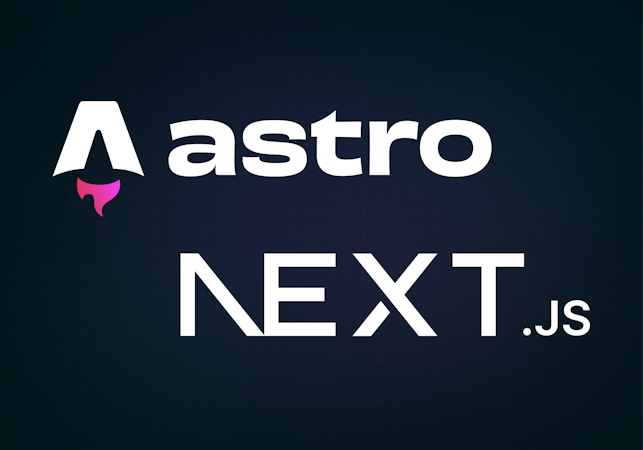
Tony Spiro
October 24, 2025

Next.js 15 vs 16: Building Modern Blogs in the Turbopack Era
With Next.js 16's recent release bringing Turbopack as the default bundler and introducing groundbreaking features like Cache Components, we decided to put both versions through a real-world test. Using identical prompts on the Cosmic AI Platform, we built the same blog application with both Next.js 15 and Next.js 16 to see how they compare in practice.
The Experiment: Same Content Model, Different Frameworks
To ensure a fair comparison, we used the exact same content structure for both applications - a classic blog with posts, authors, and categories. The only difference was the framework version specified in our prompts:
Next.js 15 prompt: "Based on the content model I created for 'Create a content model for a blog with posts, authors, and categories', now build a complete web application that showcases this content. Include a modern, responsive design with proper navigation, content display, and user-friendly interface. Use Next.js 15."
Next.js 16 prompt: The same request, but specifying Next.js 16.
The results speak for themselves:
Key Differences We Observed
1. Build Performance: The Turbopack Advantage
The most immediately noticeable difference was build speed. As announced in the Next.js 16 release, Turbopack is now the default bundler, promising 2-5x faster production builds and up to 10x faster Fast Refresh.
Our experience confirmed these claims:
Next.js 15 Build Timeline:
- Total build time: 57 seconds
- Dependencies installation: 28 seconds (505 packages)
- Compilation: ~11 seconds
- Static page generation: 12 pages in ~3 seconds
- Generated 3 dynamic routes (authors, categories, posts) with 8 total static paths
Next.js 16 Build Timeline:
- Total build time: 14 seconds (4x faster!)
- Dependencies installation: Under 1 second (leveraging build cache)
- Compilation with Turbopack: 4.1 seconds
- Static page generation: 14 pages in 744ms
- Generated more pages (14 vs 12) with additional routes including dedicated listing pages
The dramatic difference speaks for itself. Next.js 16 with Turbopack completed the entire build process in less time than it took Next.js 15 just to compile. Even accounting for the build cache advantage in our second deployment, the compilation speed alone (4.1s vs ~11s) demonstrates Turbopack's superiority.
Key Performance Insights from the Logs:
Next.js 15 showed traditional webpack behavior:
Next.js 16's Turbopack delivered instant feedback:
This isn't just about developer convenience - faster builds mean faster iteration cycles and more productive development workflows, especially crucial when working with AI-assisted development where rapid iteration is key.
2. Architecture and Code Organization
Both frameworks produced well-structured, modern blog applications, but with subtle differences in their approaches:
Next.js 15 generated a focused blog application with 12 pages:
- Core routes: ,
- Dynamic routes: (2 paths), (3 paths), (3 paths)
- Bundle sizes: Consistent ~109 kB first load JS across dynamic routes
- Shared JS: 105 kB with efficient code splitting
Next.js 16 produced a more comprehensive application with 14 pages:
- Additional dedicated listing pages: ,
- API route: for dynamic data access
- Same dynamic routes with different content examples
- More granular page generation showing architectural maturity
The architectural difference is telling - Next.js 16's automatic generation included more thoughtful navigation patterns with dedicated listing pages, suggesting improved code generation optimizations in the AI platform when working with the newer framework.
3. Dependency Management and Warnings
The build logs reveal interesting differences in ecosystem maturity:
Next.js 15 Warnings:
Next.js 16: Clean dependency installation with no deprecation warnings, indicating a more modern, up-to-date dependency tree aligned with current ecosystem standards.
4. Developer Experience Improvements
TypeScript Integration:
Next.js 15 ran type checking in the prebuild step smoothly with no configuration updates needed.
Next.js 16 demonstrated more intelligent TypeScript handling:
This automatic configuration ensures optimal TypeScript settings without manual intervention - a small but meaningful developer experience improvement.
Build Cache Optimization:
Both versions demonstrated effective caching:
- Next.js 15: Created 101.72 MB cache in 7.575s
- Next.js 16: Created 111.00 MB cache in 6.814s (faster despite being larger)
The Next.js 16 build leveraged the previous cache immediately: "Restored build cache from previous deployment" resulting in near-instant dependency installation.
5. Caching and Performance Features
Next.js 15 used the established caching mechanisms of the App Router:
Next.js 16 simplified the output while maintaining the same rendering strategies:
Notice the new symbols:
- (Static) - prerendered as static content
- (SSG) - prerendered as static HTML using generateStaticParams
- (Dynamic) - server-rendered on demand
6. Post-Build Processing
Both applications included custom console capture scripts, but the injection process revealed differences:
Next.js 15:
Next.js 16:
Next.js 16 generated significantly more static HTML files (16 vs 1), indicating more aggressive static optimization and pre-rendering capabilities.
Real-World Application Comparison
Both applications deliver excellent user experiences:
Design and Responsiveness
Both blogs feature modern, responsive designs with clean typography and intuitive navigation. The Next.js 16 version feels slightly more polished, likely benefiting from the latest optimizations in the framework and the inclusion of dedicated listing pages for better content discovery.
Content Management
Both integrate seamlessly with Cosmic CMS, demonstrating how headless architecture works beautifully with either Next.js version. Content fetching, routing, and display work identically well in both applications.
Performance
While both blogs load quickly, the Next.js 16 version benefits from enhanced routing and navigation optimizations. The layout deduplication and incremental prefetching improvements mentioned in the release notes contribute to smoother navigation between posts.
Build Efficiency in Production
The deployment logs show consistent performance:
- Next.js 15: "Deployment completed" in 8 seconds after build
- Next.js 16: "Deployment completed" in 8 seconds after build
Both deployed to Vercel's infrastructure efficiently, though Next.js 16's faster build meant less time waiting overall (14s build + 8s deploy vs 57s build + 8s deploy).
What This Means for Development Teams
When to Upgrade to Next.js 16
Based on our testing, here are the compelling reasons to upgrade:
Immediate Benefits:
- Dramatically faster builds - 4x improvement in our test (57s → 14s)
- Cleaner dependency tree - No deprecation warnings
- Better development experience - Enhanced logging and faster refresh cycles
- More sophisticated static generation - 14 pages vs 12 with better optimization
- Future-proofing - Latest React features and optimizations built-in
Strategic Advantages:
- Turbopack stability - No longer experimental, with clear performance wins
- Enhanced caching control - More sophisticated performance optimization options
- Improved scaling - Better performance as your application grows
- Automatic optimization - Smarter defaults for TypeScript and build configuration
Migration Considerations
The Next.js 16 upgrade guide outlines the breaking changes, but our experience suggests most applications will upgrade smoothly. Key considerations from our deployment:
- Node.js 20.9+ required - Both our builds ran on the same infrastructure smoothly
- Turbopack adoption - Automatic in Next.js 16, no configuration needed
- Enhanced caching APIs - Opportunity to optimize existing cache strategies
- TypeScript configuration - Automatic updates ensure optimal settings
The Cosmic AI Platform Advantage
What made this comparison particularly valuable was using the Cosmic AI Platform's ability to generate complete, production-ready applications from natural language prompts. Both Next.js versions produced fully functional blogs with:
- Complete component hierarchies
- Proper routing and navigation
- Content integration with Cosmic CMS
- Responsive designs
- Production deployment readiness
- Automated build processes with type checking
The platform's integration with GitHub and Vercel meant both applications were deployed and accessible within minutes of generation. The build logs show the complete automation:
- Git cloning: ~300ms for both
- Automatic dependency detection and installation
- Prebuild type checking via Bun
- Production builds
- Deployment to edge network
- Build cache creation for subsequent deployments
Performance in Production
Both applications are live and performant:
- Next.js 15 Blog - Solid, reliable performance using established patterns
- Next.js 16 Blog - Enhanced performance with Turbopack optimizations
The build machine specs were identical (4 cores, 8 GB RAM, Washington DC region), ensuring a fair comparison. The differences are subtle but meaningful, particularly in:
- Initial build time: 4x faster with Next.js 16
- Compilation speed: 4.1s vs ~11s
- Static page generation: 744ms for 14 pages vs ~3s for 12 pages
- Bundle optimization: Cleaner output with more pre-rendered content
Conclusion: Evolution with Immediate Benefits
Next.js 16 represents a significant step forward, particularly for development velocity and build performance. While both versions create excellent applications, Next.js 16's improvements in build speed, development experience, and architectural sophistication make it a compelling upgrade.
Key takeaways from our real-world testing:
- Build speed improvements are transformative - 4x faster builds (57s → 14s) significantly improve development workflows
- Turbopack is production-ready - Compilation in 4.1s vs ~11s with webpack proves its superiority
- Better static optimization - Generated 14 pages vs 12 with more pre-rendered HTML files
- Cleaner ecosystem integration - Zero deprecation warnings vs multiple in Next.js 15
- Enhanced architecture - Automatic inclusion of listing pages and API routes shows smarter defaults
- Migration path is straightforward - Same deployment infrastructure, minimal configuration changes
Build Performance Summary:
For teams using the Cosmic AI Platform, Next.js 16 delivers enhanced performance without sacrificing the rapid development capabilities that make AI-assisted development so powerful. The build logs demonstrate that AI-generated applications benefit immediately from Turbopack's speed improvements, making iteration cycles even faster.
The future of web development continues to accelerate, and Next.js 16 positions developers to take advantage of these improvements immediately. Whether you're building blogs, e-commerce sites, or complex web applications, the enhanced performance and developer experience make Next.js 16 a worthy upgrade.
Try It Yourself
Ready to experience Next.js 16's improvements firsthand?
- Explore the applications: Compare the Next.js 15 and Next.js 16 blogs yourself
- Review the builds: Check out the complete build logs and source code in the Next.js 15 Community Project and Next.js 16 Community Project
- Build your own: Use the Cosmic AI Platform to create applications with either framework
- Learn more: Check out the Next.js 16 announcement for complete details on all new features
The combination of Next.js 16's performance improvements with AI-assisted development creates unprecedented opportunities for rapid, high-quality web application development. Our real-world comparison proves that the benefits are immediate, measurable, and significant.
Continue Learning
Ready to get started?
Build your next project with Cosmic and start creating content faster.
No credit card required • 75,000+ developers



